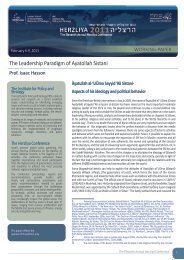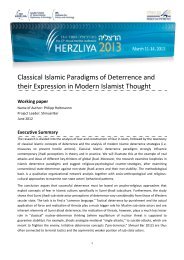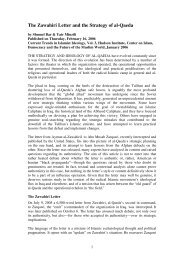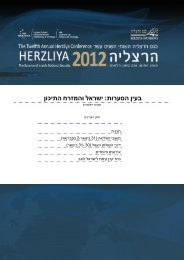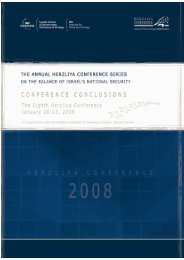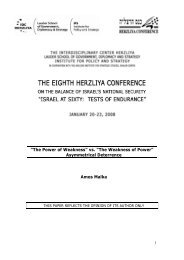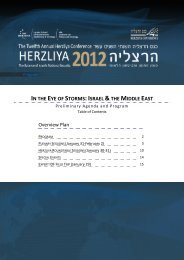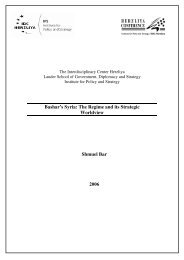Iran: Cultural Values, Self images and Negotiation Behavior
Iran: Cultural Values, Self images and Negotiation Behavior
Iran: Cultural Values, Self images and Negotiation Behavior
You also want an ePaper? Increase the reach of your titles
YUMPU automatically turns print PDFs into web optimized ePapers that Google loves.
<strong>Self</strong>-Images <strong>and</strong> StereotypesThe Shah paradigm of authority, however, is not the only one that derives fromtraditional Persian character. Another is that of the relationship between the Caliph<strong>and</strong> his Gr<strong>and</strong> Vizier. The epitome of the Gr<strong>and</strong> Vizier was that of a shrewd bazaaritypeindividual who succeeded in ingratiating himself to the Caliph (or, to that extent,with the pre-Islamic King such as in the Biblical story of Esther), <strong>and</strong> manipulatinghim. The dominant trait in this type of a relationship is, therefore, not obsequiousness,but shrewdness <strong>and</strong> court intrigue.RevolutionarismThe other side of the coin of <strong>Iran</strong>ian acceptance of authority is a predilection in<strong>Iran</strong>ian society towards revolutionarism. The wide range of words in Persian todescribe states of civil unrest is indicative of the prevalence of such a state. Theyinclude the Arabic fitnah (civil strife), fassad (corruption, sedition), inqilab (revolt)<strong>and</strong> harj-o-marj (anarchy). The first two hold clearly negative Islamic overtones,whilethe third is used to refer to the Islamic revolution. Other terms are the Persian ashub(disturbance, turmoil), naa–arami (unrest), shouresh (rebellion), eghteshash (rioting)– all having negative connotations. Modern <strong>Iran</strong>ian Persian, however, does not see allcivil disobedience as negative: the concepts of ghiyam (rebellion, used to refer to theShiites in Iraq), khizesh (jump), enghelaab (revolution), nehzat (movement) <strong>and</strong>jombesh (movement) all are seen as positive phenomena of rebellion. This tendencytowards civil disobedience <strong>and</strong> rebellion, apparent in <strong>Iran</strong> <strong>and</strong> unparalleled in theArab Middle East, has been attributed to a wide gamut of causes.Many <strong>Iran</strong>ians <strong>and</strong> sympathetic scholars ascribe it to <strong>Iran</strong>ian individualism <strong>and</strong>social mobility. According to this school of thought, <strong>Iran</strong>ian society is populist orrevolution-prone in various ways: intellectual rebellion against the Arab dominationhas persisted from the beginning of the Muslim conquest of <strong>Iran</strong> through literature<strong>and</strong> poetry. According to this view, it was expressed in the armed rebellions of AbuMuslim (747) <strong>and</strong> Babak <strong>and</strong> Mazyar (816-838), <strong>and</strong> later movements of theAssassins. This populism is attributed to motifs in <strong>Iran</strong>ian political culture rooted inthe activism of Persian Zoroastrianism <strong>and</strong> concepts of justice inherent in the ancientconcept of Kingship in <strong>Iran</strong>. These motifs were fertile ground for adoption of theegalitarian ideas of the teachings of the Prophet Mohammad. They found theirexpression in a series of political <strong>and</strong> intellectual movements: the social thought of theKhoramdin in the eighth <strong>and</strong> ninth centuries, the utopianism of the Isma’ilis <strong>and</strong>Qarmatians in the tenth through the thirteenth centuries, the populism of theSarbedaaraan <strong>and</strong> Hurufiyya movements in the fourteenth <strong>and</strong> fifteenth centuries, <strong>and</strong>the political rebellion against colonial domination in the nineteenth <strong>and</strong> twentiethcenturies. 87A parallel interpretation leans on a mixture of religious <strong>and</strong> sociological etiologies.A major tenet of <strong>Iran</strong>ian Shiite Islam is the Messianic expectation for the return of the“hidden Imam,” as the Mahdi who would deliver the world from tyranny <strong>and</strong> imposethe true m<strong>and</strong>ate of Heaven. This heavenly order is supposed to redeem the oppressedupon the earth <strong>and</strong> create a new <strong>and</strong> egalitarian social structure in the spirit of theteachings of the Prophet <strong>and</strong> the Imam ‘Ali. This fundamental belief is widely87 Manochehr Dorraj, From Zarathustra to Khomeini – Populism <strong>and</strong> Dissent in <strong>Iran</strong>(London: LynneRienner Publishers 1990): 165.21



